 |
|

|
 |
TABLE of CONTENTS
|
Course trains women, minorities for career in highway heavy construction |
By Rich Kemp
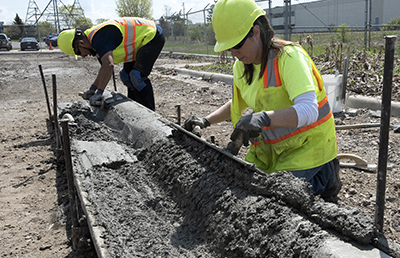
Alexis Palacios, left, and Amber Bigelow, students in the cement masons course, practice creating a curb as part of their training. Photo by Rich Kemp |
Eleven students recently graduated from a MnDOT-funded program that gives students a solid foundation in highway construction.
The students benefited from a six-week training program coordinated through the Cement Mason, Plasterers and Shophands Local 633. MnDOT partners with the Department of Employment and Economic Development to provide cement mason training for women and minorities facing disparities. The most recent class graduated May 16.
MnDOT provides funding for the program and the Office of Civil Rights plays a key role in the partnership. The applicants must have a valid driver’s license, working automobile, auto insurance and a high school diploma or GED.
“We do outreach during the offseason,” said Sylvia Garcia, DEED program coordinator. “We recruit the students through outreach in the neighborhoods, organizations, churches and the community at large.”
Training is a blend of classroom and hands-on learning where individuals learn tool use, equipment operation and safety. They also receive guidance on how to find and maintain a career in highway heavy construction.
“We start with a foundation premise of the basic hand tools to place, pour and finish concrete, and the material we are working with,” said Brian Farmer, instructor with the Cement Mason, Plasterers and Shophands Local 633. “We try to paint a picture of the responsibilities of a cement mason in the highway heavy scenario.”
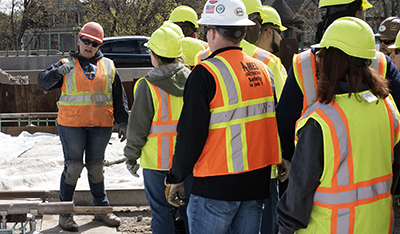
Ashley Benjamin, second-year cement mason apprentice with Lunda Construction, talks with students from the cement masons course May 10 at the I-35W construction project. She graduated from the Cement Mason MnDOT/Tribal 13 week training program in July 2018. Photo by Rich Kemp |
The training ensures students “are prepared to hit the ground running,” said Mayjoua Ly, Office of Civil Rights outreach coordinator.
“The implementation of this program has shown a great success rate as students transition from trainees to graduates,” she said. “Training is led by industry experts, and it helps to have general contractors involved in all aspects of the program.”
As the students prepare to graduate, the program helps them find jobs in highway heavy construction.
“We coordinate job fairs with employers that are wanting to hire individuals within our program,” said Garcia.
For some of the graduates, the six weeks spent in the classroom have resulted in new confidence – and new possibilities.
“I definitely learned a trade that I can do for the rest of my life,” said Amber Bigelow, cement masons student. “It has meant a different life for myself, my future and my family.”
More information about this training and other training programs can be found on the Office of Civil Rights On-the-Job Training Supportive Services website.
|
 |
|

|
 |
TABLE of CONTENTS
 |
Gov. Walz signs budget bills into law, ending 2019 Legislative session |
Hands-free cell phone, work zone safety legislation goes into effect Aug. 1
This year’s legislative session was not all about the budget. Legislators passed several standalone bills, including two aiming to increase safety on Minnesota roads.
Motorists will no longer be able to use hand-held communications devices, including cellphones, while operating a motor vehicle in traffic beginning Aug. 1.
Exceptions include using the device in hands-free mode, using one-touch navigation and audio systems, reporting emergencies and using in authorized emergency vehicles.
Violators are subject to a $125 fine for their first violation and $350 fine for subsequent offenses.
Another safety bill passed this year allows a peace officer to stop and issue a citation to a driver for a work zone violation if it is reported by a work zone flagger within four hours of the incident. The officer would not have to directly observe the violation.
The new law is modeled after similar legislation allowing citations for violations of a school bus stop arm to be issued up to four hours after the incident, based on a report from the school bus driver. The law goes into effect Aug. 1.
|
By Nick Carpenter Following five months of debate, including a day-long special session, Gov. Tim Walz capped off the 2019 Legislative session by signing 13 separate budget bills into law May 30-31.
One of those bills - the omnibus transportation finance and policy bill - appropriates funding for MnDOT and other agencies during the 2020-21 biennium. It also includes multiple policy provisions that will affect the department.
The bill does not contain any of the governor’s revenue increase proposals for transportation, including a 20-cent gas tax increase indexed to inflation, as well as registration and motor vehicle sales tax increases. It does, however, continue a transfer from the general fund to the trunk highway fund by way of the auto parts sales tax, motor vehicle rental taxes and a portion of the motor vehicle lease sales tax. The transfer amounts to approximately $122.3 million in fiscal year 2020.
The legislation also includes several budget adjustments to ensure existing operations and activities can continue in future years.
Spending increases in several areas are included in the final bill, such as a $98 million biennial increase for operations and maintenance and $25 million for program delivery. Many of these increases are meant to maintain one-time funding provided in the current biennium as ongoing base funding in the years ahead. Additional spending increases for the biennium include:
- $9.4 million for airport development and assistance, and aviation support and services
- $150 million for state road construction
- $827,000 for tribal training
The final bill does not provide additional funding for various MnDOT-related areas, including the county state-aid highway and municipal state-aid street funds. Additional areas receiving no new funding include:
- Greater Minnesota transit
- Safe Routes to School
- Corridors of Commerce
- MnDOT planning and research
Multiple policy items directly affecting MnDOT are highlighted in the bill, including one provision that authorizes truck platoons using technology for accelerating and braking. Additional bill provisions:
- Modify MnDOT’s snow and ice contingency appropriation
- Allow MnDOT to charge users of the state airplane for eventual replacement costs
- Update airport zoning laws
- Increase the department’s direct negotiation contract limit from $150,000 to $250,000
- Authorize several trunk highway turn backs to cities and counties
There are also various non-MnDOT-led policy changes related to transportation included in the bill. One change requires the department to conduct an inventory of its transportation assets. Additional provisions:
- Clarify what products can be hauled under an agriculture products permit
- Increase weights by 5 percent year-round for trucks carrying unfinished forest products
- Allow cities to establish speed limits on city streets
- Change the definition of a residential roadway so cities can set a 25 mph speed limit
- Require MnDOT and the Department of Public Safety to report to the Legislature every two years on expenditures from the trunk highway fund and highway user tax distribution fund
The full text of the bill is available online. |
 |
|

|
 |
TABLE of CONTENTS
 |
Addressing highway congestion, safety in Twin Cities metro |
|
By Susan Gergen and Gail Vold Greco, Metro District
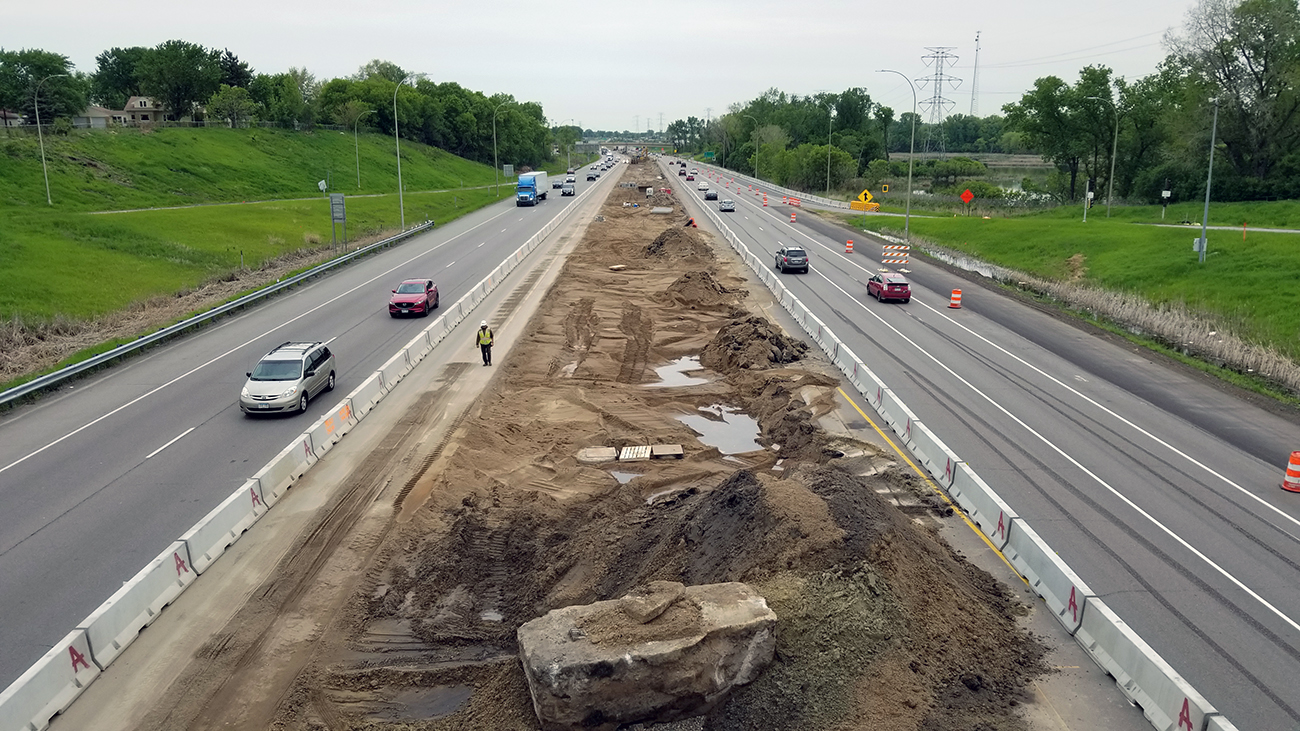
A view of the I-35W MnPASS project, looking north at County Road E2 in New Brighton/Arden Hills. Photo by Elia Ayaz |
Work has begun on I-35W North MnPASS, a three-year construction project from County Road C in Roseville to Sunset Avenue in Blaine/Lino Lakes.
The project improves highway safety, access, bridges and mobility. It also addresses highway congestion on I-35W by adding MnPASS lanes from County Road C in Roseville to Lexington Avenue in Blaine. This will be the fourth corridor in the MnPASS Express Lane System. It will also be the third route providing a MnPASS lane into Minneapolis (other routes are I-35W south and I-394).
“Blaine is one of the fastest-growing suburbs in the metro, and highway congestion on I-35W continues to increase," said Brad Larsen, MnPASS policy and planning program director. "Adding a MnPASS lane provides a dedicated lane for transit buses, car/vanpools, motorcycles and solo motorists willing to pay a fee.”
MnPASS lanes provide a more reliable commute by maximizing the number of people moved during rush hour. This benefits all motorists, including those in the general lanes. MnPASS tolling hours are 6-10 a.m. and 3-7 p.m. The lane is open to all motorists free of charge outside of these peak hours.
This unique design-build project encompasses more than adding a MnPASS lane. It will also:
- Add extra lanes to provide better access for I-35W merging, especially in the commons area with Hwy 10 and I-694 interchanges
- Replace 12 miles of pavement and ramps
- Install seven noise walls
- Replace several bridges (including at County Road C and Rosegate in Roseville and County Road I in Shoreview/Mounds View)
The project also includes extensive public outreach and engagement throughout construction. This aims to inform and involve area neighborhoods, businesses and all other stakeholders.
Learn more about I-35W North MnPASS and the MnPASS Express Lane System. |
 |
|

|
 |
TABLE of CONTENTS
 |
Report highlights recommendations for advancing transportation equity |
By Hally Turner, Office of Transportation System Management
Transportation contributes to many broad societal outcomes, such as employment, wealth and health.
Some Minnesotans, however, are underserved by current systems and face disparities and barriers in reaching their destinations. According to new research by MnDOT and the Center for Transportation Studies. Efforts to improve transportation equity need to focus on societal inequities - such as racial segregation and auto dependency - as well as the transportation barriers that affect specific communities and population groups.
Gina Baas, CTS associate director, engagement and education, was the principal investigator. The research team included co-investigator Yingling Fan, a professor, and Leoma Van Dort, research assistant, of the Humphrey School of Public Affairs and co-investigator Andrew Guthrie, former Humphrey School research fellow, now assistant professor with the University of Memphis. MnDOT funded the study.
“Some of these structural inequities, such as racialized spatial segregation in metropolitan areas and auto-dependent development patterns, are built into the very fabric of our communities,” Fan says. “The user-pay principle that governs the current transportation finance system is viewed as another inequity, as it does not take into account users’ ability to pay.”
The final report summarizes recent developments in the field of transportation equity and describes equity-focused programs within and beyond the transportation sector. Highlights from the literature and state of practice review include:
- Advancing transportation equity efforts need to focus on both the structural inequities built into society - such as auto dependency - and the transportation barriers that affect specific communities and populations
- Equity initiatives are likely to require actions beyond a transportation agency’s traditional responsibilities
- Top opportunities for advancing equity include inclusive public engagement and interagency collaboration
Study outcomes and input from project partners resulted in a series of recommendations to MnDOT to meaningfully advance transportation equity including:
- Changing policies and practices strengthening consideration of equity in planning, implementing and coordinating transportation in Minnesota
- Helping local agencies responsible for transportation improve equity considerations in their programming
- Improving equity through inter-agency coordination
MnDOT is reviewing recommendations for further research to understand how different strategies can meaningfully affect advancing transportation equity. More information is available on MnDOT’s Advancing Transportation Equity webpage. For more information, contact Hally Turner.
|
 |
|

|
 |
TABLE of CONTENTS
 |
Falgren, Stevens start new roles |
|
By Anne Meyer
Jed Falgren took the helm as the new acting state maintenance engineer May 29. He will be on mobility for the next six months.
Falgren began his career at MnDOT in 1989 and worked six years as a project engineer in the Mankato office before working 17 years in manufacturing. Falgren returned to MnDOT in 2012 to serve as District 7 assistant district engineer for Maintenance Operations. He has chaired the Maintenance Business Management Team and is a former member of the Asset Management Steering Committee, and the Transportation Systems Management and Operations Leadership Team.
Falgren and his wife, Michelle, live in Mankato and enjoy traveling.
Todd Stevens started as the new metro maintenance engineer in the Office of Operations and Maintenance May 29. Stevens had been working as the acting state maintenance engineer since November. Prior to that mobility, Stevens spent five years as the assistant district engineer for District 6 East Operations.
Stevens brings “a wealth of maintenance knowledge and will provide excellent leadership in his new role at Metro,” according to Metro Operations Director Bryan Dodds.
Stevens currently lives in Rochester with Martha, his wife of 32 years. They have three children.
|
 |
|

|
 |
TABLE of CONTENTS
 |
New online expense worksheet in RCA to improve efficiency |
By Rich Kemp
The Office of Financial Management recently released a new online expense worksheet in RCA. The new online expense form offers a variety of improvements, including:
- Automated mileage rate
- Built-in mileage calculator (replaces the MnDOT mileage charts)
- Tracking and reporting on safety boot purchases
- Auto-filled employee data
- Trackable status of business expenses
- Ability to create a reusable template
- Opportunity to save online maps for reuse
- Paperless process (eliminates wet signatures and reduces paper file storage)
- Increased accuracy of data entry
“The new expense worksheet is easy to use,” said Robin Sylvester, Office of Financial Management director. “The automation of the worksheet should provide a positive user experience and greater efficiency.”
Not all employees will have access to the form immediately. OFM will notify districts/offices of their implementation timeframe and support plan development. The implementation process will finish by Nov. 30. Visit the RCA Employee Business Expense Reference Material iHUB page for more information.
|
 |
|

|
 |
TABLE of CONTENTS
 |
Coming this summer: improved password security |
By Joseph Palmersheim
Passwords are a vital part of keeping MnDOT's information safe.
The state of Minnesota is seeing an increasing number of attacks on employee user accounts (the Active Directory credentials used to log into computers, access email, etc.). These attacks are made using the Office 365 Outlook Web Access website.
To help protect state employee and customer data, MnDOT and MNIT at DOT will be improving password security for business accounts. Re-using old passwords on employee accounts can sometimes allow attackers to gain access to employee email, organizational information and more.
So what does this mean? Going forward, new passwords must be different than previous passwords used by a user’s account. The change (not being able to use old passwords) will begin this summer, and will not affect employees until their current Active Directory passwords expire and need to be changed.
Further details (including the date these changes go into effect) will be outlined in an all-staff email, which will be sent in the next several weeks.
New passwords must use three of the four following categories:
- Lower case letters
- Upper case letters
- Numbers
- Special characters
Also, passwords must be at least:
- 8 characters for user accounts (all employees have one of these)
- 12 characters for privileged accounts (these have “ADM” after the name)
The MNIT at DOT Self-Service Password Reset service can help employees with these new changes. Similar to registering with Apple for iTunes accounts, this service will store security questions and answers for users to reset or change passwords. Learn more at the DOT MNIT Sharepoint site.
|
 |
|

|
 |
TABLE of CONTENTS
 |
What's new on the web |
By Joseph Palmersheim
MnDOT new events calendar on iHub provides a resource for event organizers to plan around upcoming meetings and events. Here is some more information on the calendar and how it works:
Categories
- Large-scale event: The event will attract regional or international visitors. The event is large scale enough to prompt an overnight stay.
- Unique event: The event is unique and noteworthy, even if it’s on a smaller scale.
- Events that support our strategic operating goals: The event furthers MnDOT's Strategic Operating Goals of Building Customer Trust, Maintaining Operational Excellence and Achieving Workforce Excellence.
- Inter-agency/partner events: Events that are hosted by partners will be included in the MnDOT event calendar if they meet aspects of the criteria outlined above.
Not included
- Business-to-business events
- Education-related events
- Fundraisers
- Religious services
|
 |
|

|
 |
TABLE of CONTENTS
 |
Metro District's Terrina White eligible for vacation donation |
|
Have some extra vacation you need to burn before the end of the fiscal year? Do you want to help out another state employee in need? You can donate up to 40 vacation hours per fiscal year. Currently, several MnDOT employees are elligible for this program.
Terrina White, transportation program specialist 3 in Metro District’s Consultant Administration Office, is eligible for the vacation donation program.
For several years, White had been misdiagnosed and living with debilitating chronic pain that baffled doctors until June 2018, when she was diagnosed with nutcracker syndrome. Nutcracker syndrome is a condition that occurs when the left renal vein (the vein that carries blood purified by the left kidney) becomes compressed between the aorta artery and superior mesenteric artery.
White had surgery in July 2018, and had additional procedures in February and March 2019 due to continued symptoms. As a result, she has exhausted all of her sick and vacation leave and has been approved for the Vacation Donation program.
Also eligible for the vacation donation program are MnDOT employees Catherine “Cate” Barrie-Medellin, transportation generalist senior with the Office of Materials and Road Research; Anne Caron, Office of Materials & Road Research; Donna Koren, Operations Division; Bruce Madson, transportation generalist in District 6; Tom Brown, transportation generalist in District 2; Donald Obernolte, Office of Environmental Stewardship; Kyle Goosman, District 8 transportation generalist senior; and Thomas Bredemus, Statewide Radio System Radio Operations Center.
To donate vacation hours, go to the Employee Self Service website and click “Other Payroll” and then “Leave Donations.” The site allows employees to view a list of all state employees eligible for the program and to enroll as a recipient.
|
 |
|

|
 |
TABLE of CONTENTS
 |
Asian Employee Resource Group welcomes state director of elections |
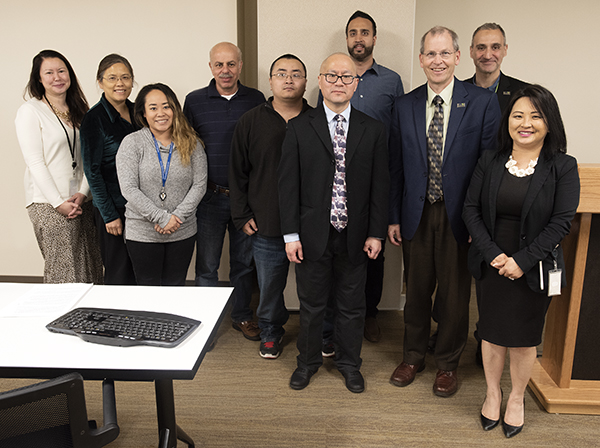
David Maeda, Secretary of State’s director of elections, spoke about his family’s Japanese-American history during a Lunch and Learn sponsored by the Asian Employee Resource Group May 21.
Above, members of the Asian ERG stand with Maeda after the event. From left are Ericca Erhard, Chief Counsel; Qin Tang, Office of Research & Innovation; Mao Lowe, Human Resources; Hatem Qamhieh, Project Management and Tech Support; Chang Pao Yang, Office of Administration; Maeda; Sulmaan Khan, Metro District; Tim Henkel, assistant commissioner in Modal Planning and Program Management (AERG champion); Amr Jabr, Operations Division assistant director (AERG champion), and Sophia Xiong-Yang, Office of Equity and Diversity. Photo by Rich Kemp |
|
 |
|

|
 |
TABLE of CONTENTS
 |
Veterans employee group discusses veteran homelessness |
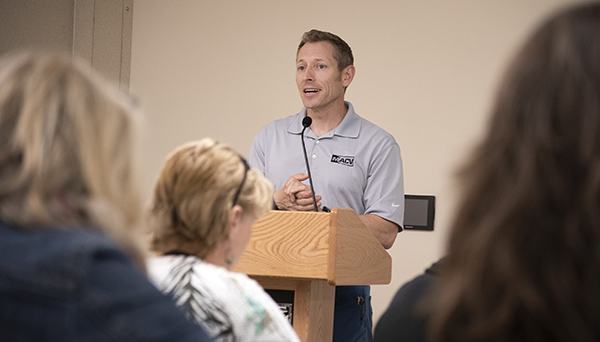
Shaun Riffe, Minnesota Assistance Council for Veterans, spoke during a Veterans Employee Resource Group Lunch and Learn May 30. Riffe talked about how MACV is committed to ending veteran homelessness in Minnesota. The organization provides emergency financial assistance, supportive housing, employment services and legal services to veterans throughout Minnesota who are homeless or at risk of homelessness. This event can be viewed on the MnDOT YouTube channel. Photo by Rich Kemp |
|
 |
|

|
 |
TABLE of CONTENTS
 |
On the Job: Keeping MnDOT machinery on the road |
By Rich Kemp
We caught up with Zach Dahring, heavy equipment service attendant in District 4, and asked him a few questions about his job.
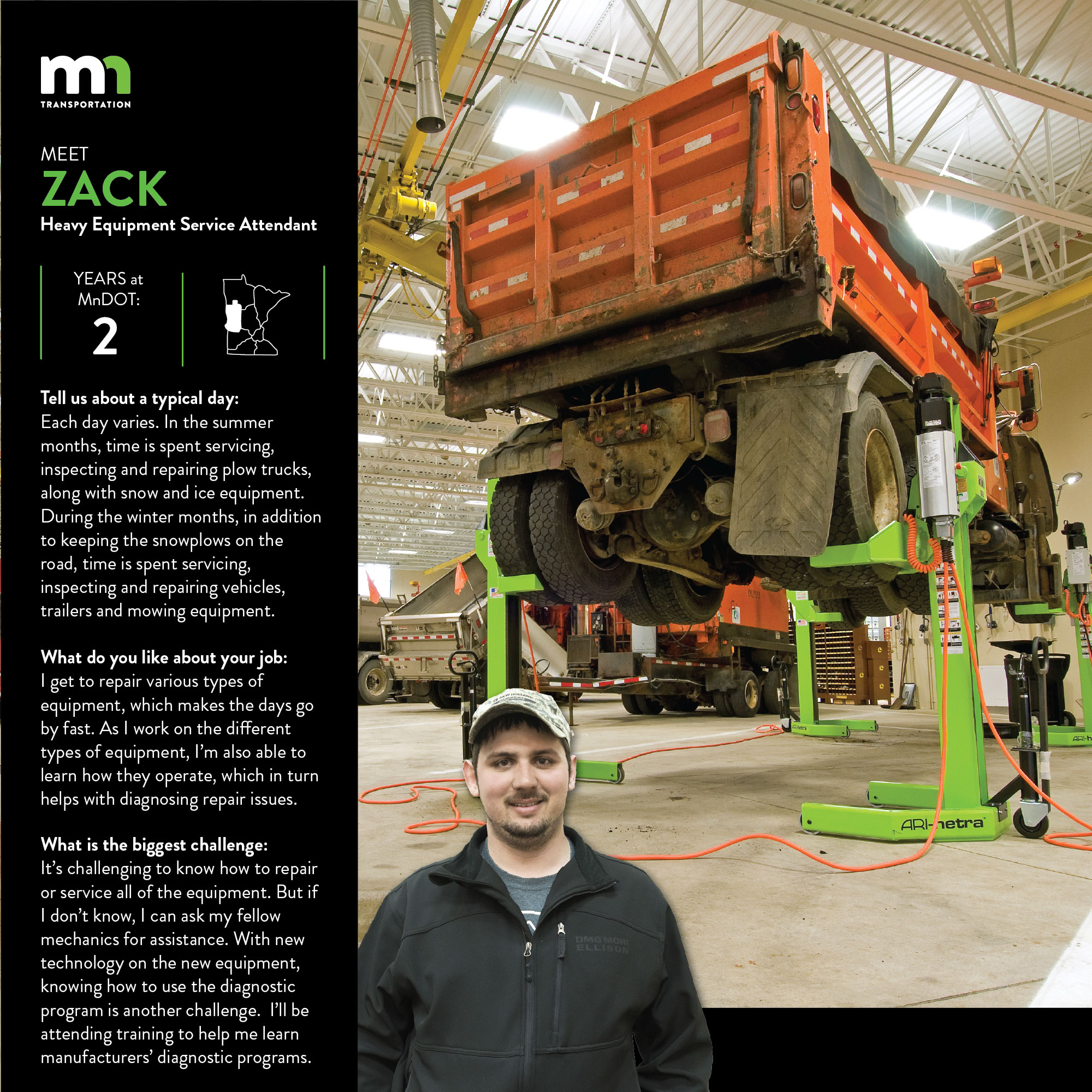
Do you or a co-worker have an interesting job to share with readers? Send us your ideas, and we’ll contact you for more information.
Recent employee profiles:
|
| |
|
| |
|



